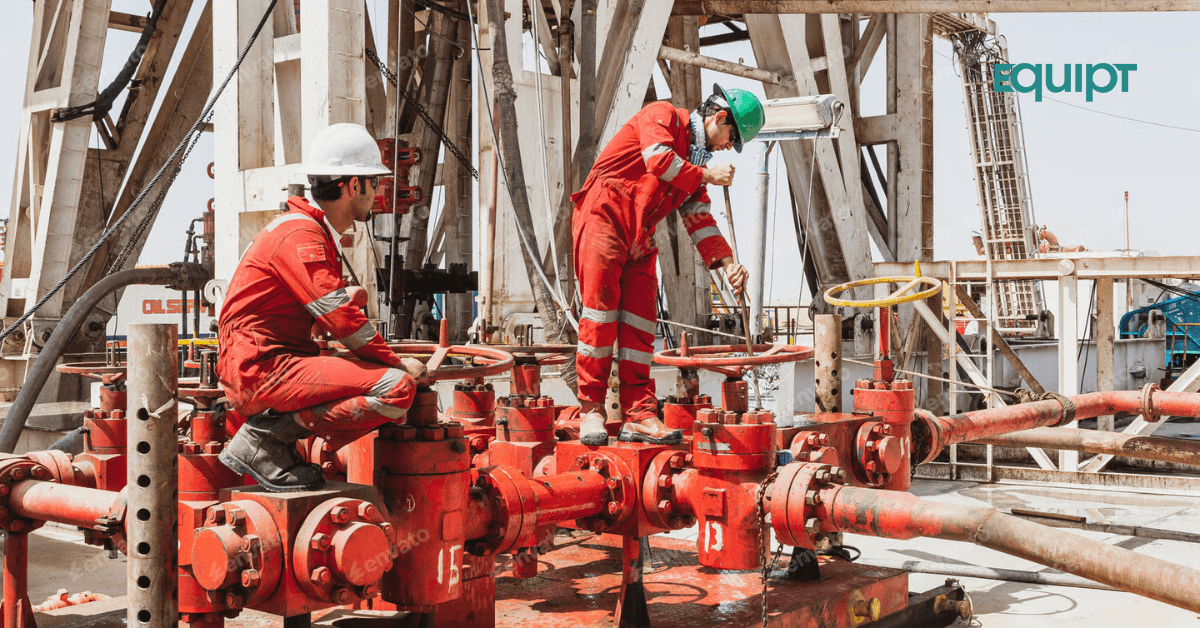AI-Driven Cost Optimization Tactics for Oilfield Equipment and Services
Discover how AI is transforming oilfield services and equipment management, boosting efficiency, cutting costs, and driving smarter operational decisions.
- Oilfield Services

Downtime in oil and gas isn’t measured in minutes—it’s measured in revenue lost, increased safety risk, and cascading operational disruption. Relying on reactive maintenance almost guarantees costly breakdowns, rushed repair bills, and lost production.
Today, leading oilfield service providers are flipping this script. By leveraging AI-enabled analytics, they’re moving from a reactive mindset to proactive, data-driven strategies. These solutions provide operators with a crucial advantage: the ability to anticipate not just if, but precisely when and where a failure might strike—so teams can schedule interventions well before problems escalate. These solutions are not just layered onto existing workflows—they’re seamlessly integrated, driving measurable reductions in emergency costs and operational risks; thus, boosting efficiency across the board and becoming the operational backbone.
This transformation is more than just an evolution in maintenance—it’s a shift in how the oil and gas industry thinks about cost control and asset management. Intelligent automation doesn’t just reduce expenses; it creates ongoing, compounding competitive advantages.
The Real Cost of Inefficiency in Modern Oilfield Operations
Most operators understand the surface-level pain points of equipment downtime: delayed projects, ballooning service costs, and disrupted schedules. What many miss is the depth of operational inefficiencies that silently erode margins. AI-powered monitoring tools don’t just track equipment—they uncover hidden costs that often go unnoticed until it’s too late, empowering data-driven decisions that protect the bottom line.
Emergency Repairs vs. Planned Maintenance: The Hidden Cost Gap
The financial toll of a sudden breakdown goes far beyond the invoice for a new part. Emergency repairs often cost three to five times more than planned maintenance—thanks to premium labor, overtime pay, last-minute shipping, and the need to work under less-than-ideal conditions.
Picture a major pump failure during peak production. While the immediate repair might run $50,000, the real hit includes lost revenue, overtime for specialized crews, helicopter transport to remote sites, and expedited delivery of parts. These “hidden” costs routinely triple the original expense.
In contrast, planned maintenance—scheduled in low-production windows, using standard shipping and regular teams—can keep the entire cost to $15,000. The difference is more than operational; it’s a strategic advantage.
Production Revenue Lost to Equipment Failures
The consequences of unplanned downtime don’t stop with repair costs. When a primary drilling motor fails, operations grind to a halt. Payroll, fuel, and support vessels continue to burn cash while production stands still. Downstream partners face delays and penalties, further multiplying the loss.
A single day of downtime on a major platform can erase $500,000 to $1 million in lost revenue. Multiply this by several incidents, and the annual losses quickly become staggering. AI-powered analytics and modern monitoring systems are now essential tools to anticipate and avoid these financial blows, enabling maintenance to be scheduled during planned windows, rather than scrambling to react after failures occur.
The Ripple Effect: When One Failure Disrupts Everything
Equipment breakdowns rarely occur in isolation. A failed pipeline compressor, for example, doesn’t just impact its immediate function—it triggers bottlenecks upstream, delivery delays downstream, and costly workarounds throughout the supply chain.
Workforce inefficiency compounds the damage. Planned operations get derailed, crews are shuffled, maintenance schedules thrown off, and logistics plans upended. It can take weeks for operations to return to full efficiency.
On top of this, regulatory compliance gets more complex. Emergency shutdowns often require environmental reviews and safety assessments, diverting resources and delaying restarts.
Equipt.ai helps operators break this reactive cycle. Its AI-driven platform provides real-time health insights, advanced risk alerts, and predictive analytics—enabling teams to identify and address equipment risks weeks in advance. With intelligent alerting, operators are notified of potential failures before they escalate, allowing for timely interventions that eliminate cascading costs.
These capabilities empower teams to move from reactive firefighting to proactive, data-driven operations—protecting margins and optimizing every stage of the equipment lifecycle.
Predictive Analytics: From Reactive Repairs to Proactive Prevention
The shift from reactive to predictive maintenance is one of the most significant transformations in oilfield management. With machine learning, vast streams of equipment data—vibration, temperature, pressure, and more—are continuously analyzed to predict failures before they happen.
Operators are now leveraging AI-driven tools to transform how maintenance is planned and executed. This technology not only detects issues early, but also correlates subtle patterns across systems, pinpointing risks that human teams might miss. As predictive models learn from more operational data, their ability to spot problems and optimize interventions grows stronger, delivering ongoing savings and greater financial predictability.
Machine Learning Models for Equipment Health Assessment
Modern AI systems don’t just collect data—they interpret it. Machine learning models sift through huge volumes of sensor data, building a detailed, dynamic health profile for each asset. As these models mature, they spot subtle deviations from normal operations—catching early signs of wear or failure that would otherwise go unnoticed.
The real breakthrough lies in correlation analysis. By connecting seemingly unrelated data points—like specific combinations of vibration, temperature, and pressure—AI uncovers patterns that consistently precede breakdowns, giving operators weeks of advance warning and actionable insights.
Early Warning Systems: Catching Problems Before They Strike
Predictive alerts give maintenance teams the upper hand. Instead of reacting to emergencies, they can schedule interventions during optimal production windows, minimizing both cost and disruption.
Organizations that implement predictive maintenance often achieve up to 50% less unplanned downtime and 25–30% lower maintenance costs within the first year1. AI-powered maintenance window optimization ensures repairs are done when operational impact is lowest, and parts ordering automation eliminates last-minute scrambles. For example, if a system predicts a pump seal will fail in three weeks, procurement teams can source components at standard rates—avoiding premium pricing and emergency logistics.
ROI Calculator: Quantifying Predictive Maintenance Savings
The business case for predictive maintenance is compelling. Companies typically report a 25-30% reduction in maintenance costs within the first year of implementation, with ROI achieved in just 12-18 months. As predictive models grow more accurate and teams build confidence in their recommendations, these benefits only accelerate.
Smart Asset Monitoring: Real-Time Intelligence for Critical Equipment
Effective predictive maintenance is built on comprehensive, continuous asset monitoring. Modern oilfield services and equipment monitoring tools use IoT sensors and edge computing to gather and analyze real-time data, delivering actionable intelligence across distributed operations. For example, IoT-enabled monitoring is routinely deployed on offshore rigs in the North Sea, remote shale fields in West Texas, and arctic drilling platforms—environments where extreme weather, saltwater exposure, or temperature swings make manual inspections difficult and costly. With these systems, operators can track equipment health and performance around the clock, regardless of location.
IoT Sensor Networks: The Digital Nervous System
Strategic sensor deployment enables 24/7 monitoring of critical parameters—without overwhelming teams with unnecessary noise. The best systems balance wide coverage with targeted, actionable insights, ensuring reliability even in remote or harsh environments.
Edge computing processes data locally, reducing bandwidth needs and latency, while wireless networks make it possible to monitor previously inaccessible sites. This digital nervous system is the backbone of modern oilfield asset management.
Remote Diagnostics: Reducing Site Visits and Inspection Costs
Virtual equipment assessments and remote diagnostics cut down on expensive, time-consuming site visits. Technicians can troubleshoot, verify repairs, and monitor health from a central dashboard, supporting multiple locations at once and responding faster when issues arise.
Continuous monitoring is far superior to periodic inspections, reducing costs while boosting accuracy and reliability.
Integration Challenges: Connecting Legacy Systems with Modern Intelligence
Many oilfield operators rely on legacy systems that weren’t built for today’s connectivity needs. Effective integration requires non-invasive solutions that enhance existing infrastructure, allowing gradual adoption of more advanced monitoring and analytics—without disrupting current operations.
Equipt.ai is purpose-built for this challenge, integrating seamlessly with legacy environments to provide clear, actionable insights from day one.
Data-Driven Decision Making: Operational Intelligence in Action
Raw data only creates value when it becomes actionable insight. The best analytics platforms transform vast information streams into clear recommendations, integrating with existing workflows for immediate operational impact. When operations get complex or exceptions multiply, intelligent filtering and prioritization ensure only the most critical insights reach your team. This prevents information overload and helps operators focus on actionable items.
Real-Time Dashboards: Visualizing Performance Across Operations
Modern dashboards visualize complex data through intuitive graphics, KPIs, and trend alerts. Performance, maintenance costs, production rates, and safety indicators are continuously updated—empowering decision-makers with a real-time view of the entire operation.
Advanced Analytics: Uncovering Hidden Patterns in Operational Data
Sophisticated analytics dig beneath the surface to identify root causes, cyclical trends, and operational interdependencies. These insights reveal not just where inefficiencies exist, but why—helping teams plan more effectively and optimize resource allocation.
Automated Reporting: From Data Collection to Strategic Insights
Automated reporting streamlines data analysis and compliance. Trends are flagged, exceptions highlighted, and specific, actionable recommendations surfaced to guide operational decisions and drive continuous improvement.
The Competitive Advantage of AI-Driven Cost Optimization
Early adopters of AI-driven cost optimization are gaining advantages that grow over time. As systems learn, and teams develop expertise, the performance gap widens—lower operating costs, improved uptime, better compliance, and greater resilience.
Equipt.ai is at the forefront, offering a unified platform for predictive maintenance, equipment monitoring, inventory management, rental job oversight, and advanced analytics. With all these capabilities under one roof, operators move from reactive firefighting to intelligent, proactive management.
Ready to see how AI-driven cost optimization can transform your operations? Schedule a demo with Equipt.ai today.

